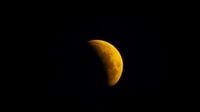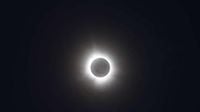On March 14, 2025, celestial enthusiasts around the globe turned their eyes to the night sky to witness a spectacular total lunar eclipse, an astronomical event that beautifully showcased the intersection of science and nature. This eclipse was marked by stunning visuals, as photographers captured the enchanting moment when the Earth’s shadow completely enveloped the moon, creating what many described as a 'blood moon.'
The March full moon, referred to as the "Worm Moon," is traditionally recognized as the final full moon of winter. However, this particular lunar event occurred under a significant backdrop; the moon's orbit is tilted approximately five degrees to the Earth’s orbit around the sun, a factor that contributes to the rarity of lunar and solar eclipses. Indeed, while there are many opportunities monthly for eclipses to occur, it is the alignment of the Earth, moon, and sun that dictates when these occurrences take place. As a result, eclipses happen only two to five times a year.
In 2025, skywatchers were fortunate to experience not only the total lunar eclipse on March 14 but also a series of other solar and lunar eclipses throughout the year. Following the total lunar eclipse, the next astronomical highlight is a partial solar eclipse scheduled for March 29, offering yet another opportunity for enthusiasts and curious observers to engage with the wonders of the cosmos.
Notably, the eclipse on March 14 was fully visible in many regions, but Germany experienced only a partial view. Photographers across the globe, including in cities like London, Seattle, and Mexico, documented the different stages of the eclipse, highlighting the moon as it transitioned into a deep red hue. This ruddiness occurs because the Earth’s atmosphere scatters sunlight, allowing only the red wavelengths to reach the moon, thus creating the fascinating visual known as a blood moon.
Photographs taken in London showed the moon about halfway covered by the Earth’s shadow as it progressed through the partial phases. In contrast, Seattle’s viewers captured the moon almost entirely eclipsed over the iconic Space Needle, while those in Mexico witnessed the full beauty of the event, showcasing the bright red moon against a dark night sky.
The rarity of lunar and solar eclipses often intrigues astronomers and casual fans alike. The specific conditions necessary for a total lunar eclipse—in which the Earth is positioned directly between the sun and the moon—means that there are periods when the moon does not align perfectly with the Earth’s shadow. Because of its inclined orbit, the moon frequently passes above or below the Earth’s shadow, which explains why total eclipses remain a rare spectacle.
For those who are interested in marking their calendars, additional lunar eclipses will occur later in 2025, with another total lunar eclipse set for September 7, and a partial solar eclipse on September 21. The latter will not be visible in Germany, but the total lunar eclipse will be an event to remember as the moon rises already fully eclipsed in many parts of the country.
As science enthusiasts have noted, while the total lunar eclipse of March 14 has come to a close, its essence lingers, reminding us of the intricate dance between celestial bodies that leads to such awe-inspiring events. Every eclipse serves as a reminder of nature’s grandeur and its ability to captivate humanity’s spirit.
In conclusion, the March 14 lunar eclipse not only marked a stunning visual phenomenon but also served to bring communities together in awe and appreciation for the cosmos. As people around the world shared their observations and photographs, the event highlighted our shared fascination with the night sky. With the anticipation of future eclipses, both amateur and seasoned astronomers alike can prepare to witness more of these breathtaking celestial displays soon.





